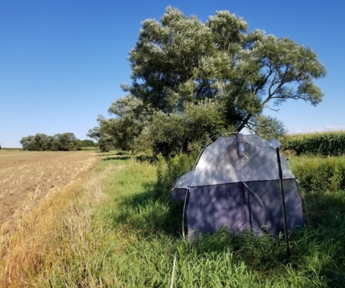Abstract
We used Malaise traps to sample arthropod community composition at biweekly intervals across an agroecosystem landscape in southern Ontario, Canada, to evaluate the relative impact of site spacing, seasonal timing, weather conditions, local plant community attributes, and agricultural extent across the local landscape on spatial and temporal variation in arthropod community composition. The 15 field sites sampled spanned a wide gradient of agricultural extent that in isolation had a strong impact on spatial variation in arthropod community composition. DNA metabarcoding of the samples identified >10 000 different arthropod biodiversity index numbers. Local variation in plant community composition and canopy cover best explained variation in arthropod community dissimilarity. Weather variables followed closely in explanatory power, driven primarily by seasonal variation in temperature. Significant effects of time remained after accounting for environmental variables, with little independent effect of spatial distance. The proportion of agricultural land at the landscape scale had little detectable effect after controlling for the influence of the other environmental variables. Our results suggest that plant community composition, cover, weather conditions, and seasonality structured the arthropod community to considerable degree.
Introduction
Rapid declines in arthropod abundance and species diversity across the globe have received a great deal of recent attention (Gossner et al. 2016; Hallmann et al. 2017; Sánchez-Bayo and Wyckhuys 2019; Seibold et al. 2019; Wagner et al. 2021). These drastic changes in arthropod communities are a major cause for concern, given their enormous taxonomic and functional diversity and critical role in the provisioning of vital ecological services such as pollination, pest control, and nutrient cycling (Kremen et al. 1993; Stork 2018). Although the causes of arthropod declines are surely complex and multi-faceted, habitat loss and external inputs associated with agriculture are frequently identified as primary drivers (Gossner et al. 2016; Sánchez-Bayo and Wyckhuys 2019; Seibold et al. 2019; Wagner 2020). Recent work suggests, however, that arthropod declines are not universal (Crossley et al. 2020; van Klink et al. 2020), raising fundamental questions about the regulation of arthropod biodiversity in agroecosystems (Wagner 2020).
Agroecosystems contain a mosaic of crop and non-crop habitat, the balance of which is an important determinant of arthropod biodiversity as non-crop habitat provides a spatiotemporally stable source of food, shelter, nesting, and mating resources (Dolezal et al. 2022). Specifically, variation in arthropod community composition has been linked to local attributes, including plant biomass, structural complexity, and plant community composition (Stinson and Brown 1983; Schaffers et al. 2008; Borer et al. 2012; Prather and Kaspari 2019) as well as landscape-level measures of habitat diversity, land-use intensity, landscape connectivity, and landscape complexity (Schweiger et al. 2005; Hendrickx et al. 2007; Fahrig et al. 2011; Gossner et al. 2016; Seibold et al. 2019). Compositional differences in arthropod communities may also result from dispersal limitation and ecological drift, effects of which are often exacerbated by patch isolation and especially affect groups with limited dispersal ability (Bell 2001; Hubbell 2001; Vellend 2010). This is significant since many arthropod taxa have rapid generation times and thus the influences of temporal and spatial processes on community divergence can be powerful even within a single growing season (Kingsolver 1989; Chown and Gaston 1999). Given the paucity of non-crop habitat in many agroecosystems, measures aimed at maintaining and restoring natural areas can be very effective in promoting arthropod biodiversity (Paterson et al. 2019; Dolezal et al. 2022). Several studies have demonstrated that restored habitat can lead to an increase in arthropod richness and abundance, often with positive effects on ecosystem services such as herbivore suppression, pollination, and predation services (Albrecht et al. 2020; Paterson et al. 2019; Dolezal et al. 2022).
Most of these community-shaping processes have been investigated from a spatial perspective, but temporal factors can also play a central role (Grøtan et al. 2012). Seasonality is particularly important in many systems, stemming from an interplay of species-specific responses to abiotic conditions, such as temperature and precipitation, biotic conditions, such as plant resource availability, and stochastic variation through time (Wolda 1978, 1988; Stinson and Brown 1983; Grøtan et al. 2012; Hatosy et al. 2013). Previous studies have found that the effect of habitat composition and the configuration of those habitats in the landscape on arthropod communities can vary across the growing season (Bertrand et al. 2016) and that landscape composition can modulate phenological diversity (Sydenham et al. 2014). Even in tropical systems with less pronounced seasonality compared to temperate regions, arthropod community composition in both natural forests and rubber plantations shows high seasonal turnover (Beng et al. 2018). Arthropods living in agroecosystems experience both seasonal climatic variation and season-dependent management actions such as plowing, planting, and pesticide application (Anderson et al. 2012; Beckmann et al. 2019; Hausmann et al. 2019).


